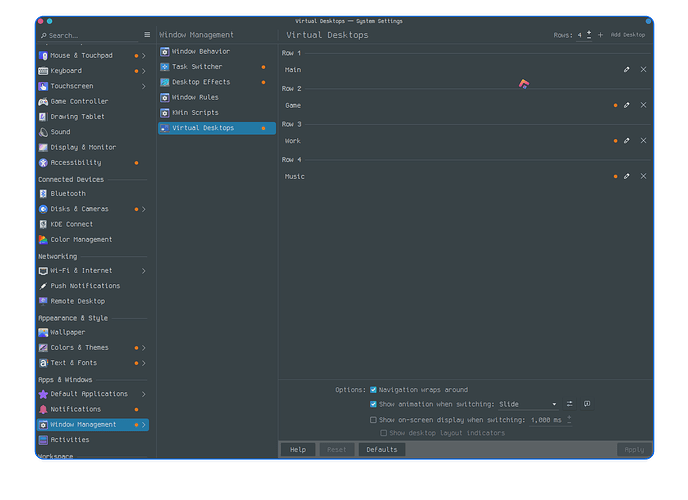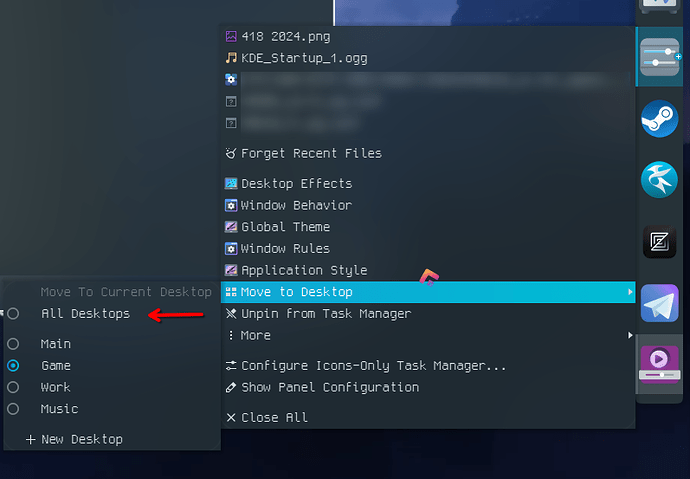I’m experiencing an issue with virtual desktops in Garuda Linux, and I’m hoping someone can help me resolve it. When I try to open a new virtual desktop, it automatically carries over all the apps from the previous desktop. This behaviour is quite frustrating because if I open an app on the new desktop, it switches back to the first desktop, which defeats the purpose of having multiple desktops.
I want to be able to open a new virtual desktop that is completely fresh, without any apps from the previous desktop being opened there. I’ve tried a few things to fix this, but so far, nothing has worked.
Here’s what I’ve tried:
- Checking the desktop environment settings (I’m using KDE Plasma).
- Looking for any settings related to virtual desktops in the system configuration.
- Restarting the session and even rebooting the system.
garuda-inxi:
System:
Kernel: 6.12.8-zen1-1-zen arch: x86_64 bits: 64 compiler: gcc v: 14.2.1
clocksource: tsc avail: acpi_pm
parameters: BOOT_IMAGE=/@/boot/vmlinuz-linux-zen
root=UUID=880bb618-c2bf-46dd-8da1-2d21171aab87 rw rootflags=subvol=@
quiet loglevel=3 ibt=off
Desktop: KDE Plasma v: 6.2.5 tk: Qt v: N/A info: frameworks v: 6.9.0
wm: kwin_wayland with: krunner vt: 1 dm: SDDM Distro: Garuda
base: Arch Linux
Machine:
Type: Laptop System: HP product: HP ProBook 450 G5 v: N/A
serial: <superuser required> Chassis: type: 10 serial: <superuser required>
Mobo: HP model: 837D v: KBC Version 02.41.00 serial: <superuser required>
part-nu: 3MC66PA#UUF uuid: <superuser required> UEFI: HP
v: Q85 Ver. 01.23.00 date: 11/29/2022
Battery:
ID-1: BAT0 charge: 28.0 Wh (66.5%) condition: 42.1/48.0 Wh (87.7%)
volts: 11.5 min: 11.4 model: Hewlett-Packard Primary type: Li-ion
serial: <filter> status: discharging cycles: 88
CPU:
Info: model: Intel Core i3-7100U bits: 64 type: MT MCP arch: Amber/Kaby Lake
note: check gen: core 7 level: v3 note: check built: 2017
process: Intel 14nm family: 6 model-id: 0x8E (142) stepping: 9
microcode: 0xF6
Topology: cpus: 1x dies: 1 clusters: 2 cores: 2 threads: 4 tpc: 2
smt: enabled cache: L1: 128 KiB desc: d-2x32 KiB; i-2x32 KiB L2: 512 KiB
desc: 2x256 KiB L3: 3 MiB desc: 1x3 MiB
Speed (MHz): avg: 800 min/max: 400/2400 scaling: driver: intel_pstate
governor: powersave cores: 1: 800 2: 800 3: 800 4: 800 bogomips: 19200
Flags: avx avx2 ht lm nx pae sse sse2 sse3 sse4_1 sse4_2 ssse3 vmx
Vulnerabilities: <filter>
Graphics:
Device-1: Intel HD Graphics 620 vendor: Hewlett-Packard driver: i915
v: kernel arch: Gen-9.5 process: Intel 14nm built: 2016-20 ports:
active: eDP-1 empty: DP-1,HDMI-A-1,HDMI-A-2 bus-ID: 00:02.0
chip-ID: 8086:5916 class-ID: 0300
Device-2: Chicony HP HD Camera driver: uvcvideo type: USB rev: 2.0
speed: 480 Mb/s lanes: 1 mode: 2.0 bus-ID: 1-6:3 chip-ID: 04f2:b5ee
class-ID: 0e02
Display: wayland server: X.org v: 1.21.1.15 with: Xwayland v: 24.1.4
compositor: kwin_wayland driver: X: loaded: modesetting
alternate: fbdev,intel,vesa dri: iris gpu: i915 display-ID: 0
Monitor-1: eDP-1 res: 1366x768 size: N/A modes: N/A
API: EGL v: 1.5 hw: drv: intel iris platforms: device: 0 drv: iris
device: 1 drv: swrast gbm: drv: iris surfaceless: drv: iris wayland:
drv: iris x11: drv: iris
API: OpenGL v: 4.6 compat-v: 4.5 vendor: intel mesa v: 24.3.3-arch1.1
glx-v: 1.4 direct-render: yes renderer: Mesa Intel HD Graphics 620 (KBL GT2)
device-ID: 8086:5916 memory: 3.73 GiB unified: yes display-ID: :1.0
API: Vulkan v: 1.4.303 layers: 8 device: 0 type: integrated-gpu name: Intel
HD Graphics 620 (KBL GT2) driver: N/A device-ID: 8086:5916
surfaces: xcb,xlib,wayland device: 1 type: cpu name: llvmpipe (LLVM
18.1.8 256 bits) driver: N/A device-ID: 10005:0000
surfaces: xcb,xlib,wayland
Audio:
Device-1: Intel Sunrise Point-LP HD Audio vendor: Hewlett-Packard
driver: snd_hda_intel v: kernel alternate: snd_soc_avs bus-ID: 00:1f.3
chip-ID: 8086:9d71 class-ID: 0403
API: ALSA v: k6.12.8-zen1-1-zen status: kernel-api tools: N/A
Server-1: PipeWire v: 1.2.7 status: active with: 1: pipewire-pulse
status: active 2: wireplumber status: active 3: pipewire-alsa type: plugin
4: pw-jack type: plugin tools: pactl,pw-cat,pw-cli,wpctl
Network:
Device-1: Realtek RTL8111/8168/8211/8411 PCI Express Gigabit Ethernet
vendor: Hewlett-Packard driver: r8169 v: kernel pcie: gen: 1 speed: 2.5 GT/s
lanes: 1 port: 3000 bus-ID: 01:00.0 chip-ID: 10ec:8168 class-ID: 0200
IF: enp1s0 state: down mac: <filter>
Device-2: Intel Dual Band Wireless-AC 3168NGW [Stone Peak] driver: iwlwifi
v: kernel pcie: gen: 1 speed: 2.5 GT/s lanes: 1 bus-ID: 02:00.0
chip-ID: 8086:24fb class-ID: 0280
IF: wlp2s0 state: up mac: <filter>
Info: services: NetworkManager, smbd, systemd-timesyncd, wpa_supplicant
Bluetooth:
Device-1: Intel Wireless-AC 3168 Bluetooth driver: btusb v: 0.8 type: USB
rev: 2.0 speed: 12 Mb/s lanes: 1 mode: 1.1 bus-ID: 1-7:4 chip-ID: 8087:0aa7
class-ID: e001
Report: btmgmt ID: hci0 rfk-id: 5 state: up address: <filter> bt-v: 4.2
lmp-v: 8 status: discoverable: no pairing: no class-ID: 6c010c
Drives:
Local Storage: total: 111.79 GiB used: 54.84 GiB (49.1%)
SMART Message: Unable to run smartctl. Root privileges required.
ID-1: /dev/nvme0n1 maj-min: 259:0 vendor: HP model: SSD EX900 120GB
size: 111.79 GiB block-size: physical: 512 B logical: 512 B speed: 31.6 Gb/s
lanes: 4 tech: SSD serial: <filter> fw-rev: T1103F0L temp: 34.9 C
scheme: GPT
Partition:
ID-1: / raw-size: 111.49 GiB size: 111.49 GiB (100.00%)
used: 54.84 GiB (49.2%) fs: btrfs dev: /dev/nvme0n1p2 maj-min: 259:2
ID-2: /boot/efi raw-size: 300 MiB size: 299.4 MiB (99.80%)
used: 584 KiB (0.2%) fs: vfat dev: /dev/nvme0n1p1 maj-min: 259:1
ID-3: /home raw-size: 111.49 GiB size: 111.49 GiB (100.00%)
used: 54.84 GiB (49.2%) fs: btrfs dev: /dev/nvme0n1p2 maj-min: 259:2
ID-4: /var/log raw-size: 111.49 GiB size: 111.49 GiB (100.00%)
used: 54.84 GiB (49.2%) fs: btrfs dev: /dev/nvme0n1p2 maj-min: 259:2
ID-5: /var/tmp raw-size: 111.49 GiB size: 111.49 GiB (100.00%)
used: 54.84 GiB (49.2%) fs: btrfs dev: /dev/nvme0n1p2 maj-min: 259:2
Swap:
Kernel: swappiness: 133 (default 60) cache-pressure: 100 (default) zswap: no
ID-1: swap-1 type: zram size: 7.64 GiB used: 2.56 GiB (33.5%)
priority: 100 comp: zstd avail: lzo-rle,lzo,lz4,lz4hc,deflate,842
max-streams: 4 dev: /dev/zram0
Sensors:
System Temperatures: cpu: 47.0 C pch: 40.5 C mobo: N/A
Fan Speeds (rpm): N/A
Info:
Memory: total: 8 GiB note: est. available: 7.65 GiB used: 5.71 GiB (74.7%)
Processes: 278 Power: uptime: 1d 9h 49m states: freeze,mem,disk
suspend: deep avail: s2idle wakeups: 4 hibernate: platform avail: shutdown,
reboot, suspend, test_resume image: 3.05 GiB services: org_kde_powerdevil,
power-profiles-daemon, upowerd Init: systemd v: 257 default: graphical
tool: systemctl
Packages: 1530 pm: pacman pkgs: 1522 libs: 415 tools: octopi,paru
pm: flatpak pkgs: 8 Compilers: gcc: 14.2.1 Shell: garuda-inxi default: fish
v: 3.7.1 running-in: konsole inxi: 3.3.36
Garuda (2.6.26-1.1):
System install date: 2024-12-19
Last full system update: 2025-01-11 ↻
Is partially upgraded: No
Relevant software: snapper NetworkManager dracut
Windows dual boot: No/Undetected
Failed units:


